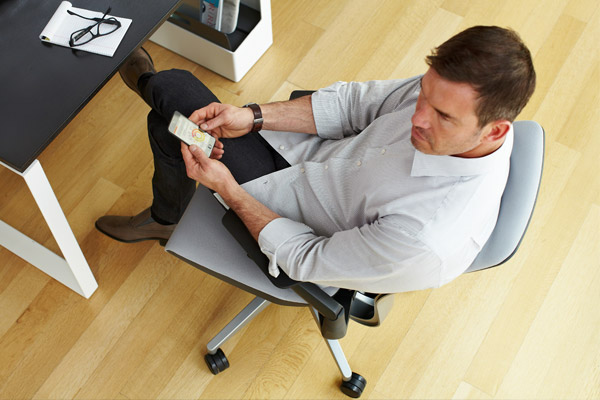Do you strunch, trance or simply take it all in? Alice Blackwood discovers that a new study by Steelcase has found that the way we work today – across multiple devices and in increasingly untraditional formats – has shifted our ergonomic needs.

November 29th, 2013
The launch of the Gesture task chair by Steelcase earlier this month has seeded a new conversation within workplace contexts, that is less about desk height and keyboard posture, and more about how to support our chair slouching, desk hunching and multi-device ‘tasking’.
The Gesture appears as most task chairs would, but it is the flexibility and ease of use, aided by specially developed core, upper limb and seat interfaces, that makes this new release so unique.
Developed in response to Steelcase’s latest research into changing workplace postures, the Gesture has been designed to service 9 new seating postures which – whether we realise it or not – we’ve been adopting, while at work.
The study, which was conducted across 11 countries and encompassed over 2000 people, threw up some very interesting findings: we are no longer confined to PCs and desktop computers, but tend to work across many devices – large and small – and simultaneously.
Among the 9 new multi-device-driven postures discovered was The Strunch, in which we push our laptops to the back of our desks and hunch over to reach the keyboard; and The Trance which describes that deep concentration that prompts us to lean towards the screen and strain our necks forward.
There’s also The Take It In, which often happens when we work on large monitors, and find ourselves reclining backwards to ‘take it in’.
Responding to these unconventional sitting styles, Gesture has been constructed as a system of interconnected parts, inspired by the body and designed to support all our movements. It caters for a broad range of body sizes and its settings are easily adaptable and intuitive to use, (ie. no fumbling for the height lever!).
Particularly with the increased take-up of Activity Based Working within large organisations, the Gesture offers versatility and flexibility, catering to a wide variety of users and user needs, across any working environment.
Its customisable colour and finish options aside, the Gesture could be shared across a number of workers and because it is designed to move with us and respond easily to our personal seating preferences, it offers an interchangeability that reflects our modern working styles and workspace environments.
In addition to the The Strunch, The Trance, and The Take It in, Steelcase found 6 other tech-driven postures. These include:
The Draw: The popular take-up of tablets as part of our working day sees us lean back slightly and draw these small, mobile devices towards us, causing arm and shoulder fatigue over time.
The Multi-Device: Here we draw our smartphones or tablets towards us to text, search or talk, while simultaneously working away at our laptops and computers.
The Smart Lean: As we receive information on our smartphones we tend to shift to the side to preserve privacy; the back support lost often results in disc compression and back pain.
The Text: Texting is a frequent activity and often finds us spending long moments concentrating on ‘tiny typing’; the lack of arm support involved in this activity creates shoulder strain.
The Cocoon: With smaller devices, we tend to recline and draw our tablets close, though the bend in the knee can reduce circulation.
The Swipe: In placing a small device – like a tablet – on a table surface our bodies naturally hunch forward, creating a sharp, downward neck angle.
Find out more about the 9 postures and how Gesture combats these, here.
Steelcase
steelcase.en
INDESIGN is on instagram
Follow @indesignlive
A searchable and comprehensive guide for specifying leading products and their suppliers
Keep up to date with the latest and greatest from our industry BFF's!

Within the intimate confines of compact living, where space is at a premium, efficiency is critical and dining out often trumps home cooking, Gaggenau’s 400 Series Culinary Drawer proves that limited space can, in fact, unlock unlimited culinary possibilities.

In design, the concept of absence is particularly powerful – it’s the abundant potential of deliberate non-presence that amplifies the impact of what is. And it is this realm of sophisticated subtraction that Gaggenau’s Dishwasher 400 Series so generously – and quietly – occupies.

Matching style with a capacity to maximise workplace performance, these office chairs lead the field in terms of carbon abatement and sustainability.

It was a night to remember as the 2024 INDE.Awards gala delivered an amazing evening of architecture and design, and also provided the opportunity to renew connections, make new friends and just have fun!

The winners of the 2024 INDE.Awards were announced at a spectacular gala hosted by The Ritz-Carlton, Melbourne, Australia. Discover the exemplary projects, people and products that reflect the diversity of the Indo-Pacific.
The internet never sleeps! Here's the stuff you might have missed

Wendelbo stands as an example of a family-operated business that has profitably adapted to the modern world without losing sight of its values.

A new residential building is paving the way for great design in northwest Sydney and Cox Architecture is at the forefront of making change for the better.